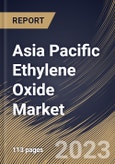Ethylene oxide is a precursor for various chemicals and intermediates, including ethylene glycols, ethoxylates, and glycol ethers. These derivatives find applications in products like antifreeze, detergents, solvents, and plastics. Ethylene glycols, produced from ethylene oxide, are used in the automotive industry as antifreeze and brake fluids, helping to prevent engine freezing and maintain braking performance in various weather conditions. It is used in textile processing to produce ethoxylated textile chemicals that enhance fabric softness, dyeability, and other characteristics. EO is used to produce certain pesticides and herbicides used in agriculture. Ongoing research and technological advancements in EO production processes, such as catalytic and energy-efficient methods, can increase efficiency and reduce production costs, thereby encouraging market growth.
As population continue to grow and urbanize, there is an increased need for various consumer products, including personal care items, textiles, and healthcare products, all of which use EO derivatives. Ethylene oxide produces non-ionic surfactants and emulsifiers that find applications in detergents, soaps, shampoos, and other cleaning and personal care products. It is used to ethoxylate various compounds, such as fatty alcohols and alkylphenols, to create surfactants and detergents. It produces certain agricultural chemicals, including herbicides and pesticides. It is a highly effective sterilizing agent for medical devices, pharmaceuticals, and food products. Its ability to penetrate packaging materials makes it valuable in ensuring the sterility of sensitive products. It is used to synthesize various chemical intermediates, which in turn are used to produce plastics, rubber, and other materials. Ethylene oxide-based heat transfer fluids are used in industrial heating and cooling systems.
China has steadily expanded its healthcare infrastructure, including new hospitals and healthcare facilities. As the number of medical facilities grows, so does the demand for EO for sterilizing medical equipment and supplies. Rising healthcare expenditure in China has increased demand for medical devices and pharmaceutical products, many requiring EO sterilization. China is a major producer of medical devices and equipment, including surgical instruments, implants, and diagnostic devices. EO is critical in sterilizing these products, ensuring their safety and effectiveness. The pharmaceutical industry in China has experienced significant growth. EO sterilizes pharmaceutical packaging, drug delivery systems, and production equipment. Hospitals and healthcare facilities across China rely on EO sterilization for various applications, from surgical instruments to patient-care items. The demand for sterilization services remains high. The healthcare sector's demand for EO in China is expected to remain strong as the country invests in healthcare infrastructure, awareness, and access.
On December 28, China presented a plan for the growth of the medical equipment industry throughout the 14th Five-Year Plan (2021–2025). By 2025, the nation aims to rapidly adopt information technology in the medical equipment sector, leading to the development of digital health platforms and medical robots. The plan, published jointly by ten government agencies, also outlines measures to develop medical equipment to support community-based care for older people in direct response to the national strategy for population aging. The medical equipment sector in China has increased during the last five years, with a market size of 840 billion yuan (about $131.81 billion) in 2020. Therefore, owing to all of the aforementioned factors, the regional market will grow rapidly in the coming years.
The China market dominated the Asia Pacific Ethylene Oxide Market by Country in 2022, and would continue to be a dominant market till 2030; thereby, achieving a market value of $6,939.2 million by 2030. The Japan market is registering a CAGR of 4.1% during (2023 - 2030). Additionally, The India market would showcase a CAGR of 5.4% during (2023 - 2030).
Based on Application, the market is segmented into Ethylene Glycol, Ethoxylates, Ethanolamines, Polyols, and Others. Based on countries, the market is segmented into China, Japan, India, South Korea, Singapore, Malaysia, and Rest of Asia Pacific.
The market research report covers the analysis of key stake holders of the market. Key companies profiled in the report include Akzo Nobel N.V., BASF SE, Shell plc, Clariant AG, The Dow Chemical Company (Dow Corning Ltd.), Exxon Mobil Corporation, Formosa Plastics Group, LOTTE Chemical Corporation (LOTTE Corp.), Huntsman Corporation, and SABIC (Saudi Arabian Oil Company).
Scope of the Study
Market Segments Covered in the Report:
By Application (Volume, Kilo Tonnes, USD Million, 2019-2030)- Ethylene Glycol
- Ethoxylates
- Ethanolamines
- Polyols
- Others
- China
- Japan
- India
- South Korea
- Singapore
- Malaysia
- Rest of Asia Pacific
Key Market Players
List of Companies Profiled in the Report:
- Akzo Nobel N.V.
- BASF SE
- Shell plc
- Clariant AG
- The Dow Chemical Company (Dow Corning Ltd.)
- Exxon Mobil Corporation
- Formosa Plastics Group
- LOTTE Chemical Corporation (LOTTE Corp.)
- Huntsman Corporation
- SABIC (Saudi Arabian Oil Company)
Unique Offerings
- Exhaustive coverage
- The highest number of Market tables and figures
- Subscription-based model available
- Guaranteed best price
- Assured post sales research support with 10% customization free
Table of Contents
Companies Mentioned
- Akzo Nobel N.V.
- BASF SE
- Shell plc
- Clariant AG
- The Dow Chemical Company (Dow Corning Ltd.)
- Exxon Mobil Corporation
- Formosa Plastics Group
- LOTTE Chemical Corporation (LOTTE Corp.)
- Huntsman Corporation
- SABIC (Saudi Arabian Oil Company)








